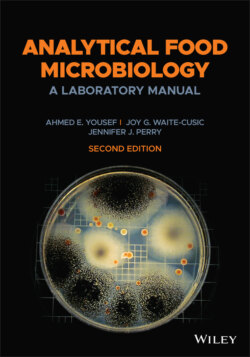Читать книгу Analytical Food Microbiology - Ahmed E. Yousef - Страница 61
Plates with colonies in the range of 20–200 (the best possible scenario)
ОглавлениеAlthough other references may use 30 to 300 or 25 to 250 colonies as suitable countable bacterial colonies on a plate, the range 20–200 will be used throughout this book. If plating yields plates with colony counts in the range of 20–200/plate (as judged by a preliminary estimation), discard all remaining plates and count colonies only on the plates in this range. Calculate the CFU/g using equation 3.7. Familiarity with equation 3.7 is important. Examples of dilution factors are 1/10 (i.e., 10–1) and 1/100 (i.e., 10–2), and the volume plated is commonly 1 or 0.1 ml.
Duplicate plates with colony counts in the 20–200 range are ideally obtained from one dilution only. When this condition is not met, the following rules are applied.
One plate in the 20–200 range. If the exercise yields only one plate with a colony count in the range of 20–200, calculate the CFU/g in the original sample using the number of colonies on that plate instead of an average.
Consecutive dilutions producing plates in the 20–200 range. If plates from two consecutive dilutions yield 20–200 colonies, compute the CFU/g resulting for each of the two dilutions. If the two population counts are not appreciably different (e.g., 1.5×104 and 1.2×104 CFU/g), average the numbers and report the average as sample population count. If the numbers are substantially different (e.g., the higher CFU/g is more than twice the lower one), report only the lower computed CFU/g.
